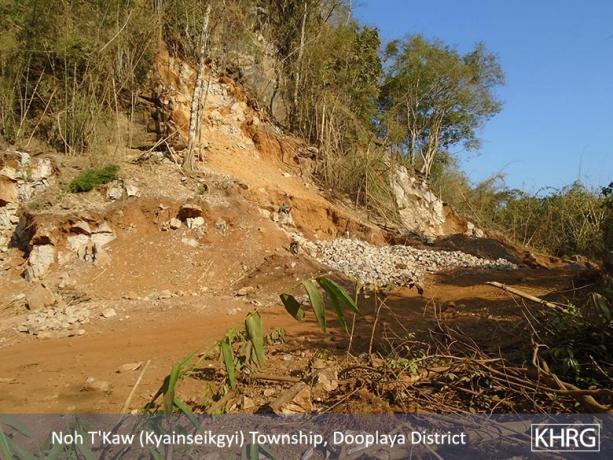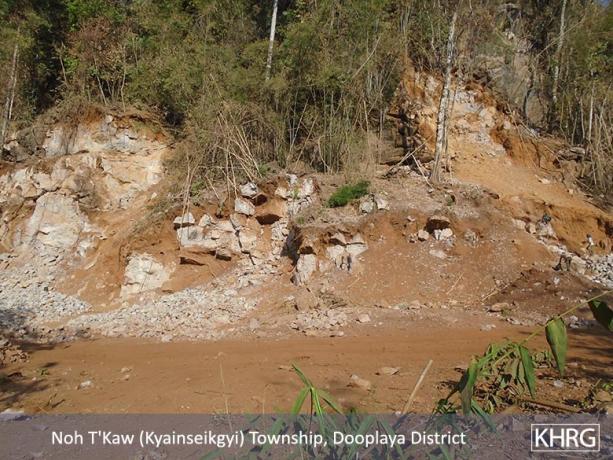This Photo Set illustrates road construction documented between December 2016 and March 2017 across four districts in KHRG research areas of southeast Myanmar. The roads are constructed by the Myanmar government, Tatmadaw and private companies, the names of some companies are unknown. Although road construction is part of a series of development projects initiated to improve the country’s infrastructure, many local villagers still hold negative opinions about the road construction due to the destruction of their land and plantations during construction. Villagers also are concerned that the road constructions have been implemented without proper consultation or compensation. In addition, when road construction has been implemented by the Tatmadaw, villagers have not dared to complain or ask for compensation even though they are not happy with the negative impacts of the road construction.
Photo Set | Toungoo, Nyaunglebin, Mergui-Tavoy and Dooplaya districts (December 2016 to March 2017)
The following photos were taken by community members in Toungoo, Nyaunglebin, Mergui-Tavoy and Dooplaya districts, who have been trained by KHRG to monitor human rights conditions. They are presented below, censored where necessary for security purposes.[1]The 22 photos below were received along with other information from Toungoo, Nyaunglebin, Mergui-Tavoy and Dooplaya districts including other photos, video clips, interviews and a general update on the situation.[2]
The first two photos were taken on January 21st 2017 by a KHRG community member in the north of A--- village, Shan Lel Pyin village tract, Leik Tho Town, Thanduanggyi Township, Toungoo District. It shows a newly constructed road and a signboard from the Borderline Development Project, implemented by Burma/Myanmar Government [at the Kayin State level]. According to the information stated on the signboard, the project name is Leik Though-Shan Lel Pyin 3/2 Mile unpaved road, the road construction period was from 2016-2017 and the budget for the road is over 56 billion kyat [US $41,380,000][3]. This road construction was started on October 2016 and finished in March 2017. It was implemented by Way Bone Kyaw Company. These photos are included here to show the frequency of the road construction happening in Toungoo District during the reporting period. In this case the KHRG community member could not access any villagers to gather local perspectives on the construction. [Photos: KHRG]
The second two photos (below) were taken by a KHRG community member on January 21st 2017 in B--- [foothill village], Meh Tha Lin Taung village tract, Leik Tho Town, Thandaunggyi Township, Toungoo District. It shows Way Pone Kyaw Company constructing a road. The owner of the company is Bo[4] Kyaw Win who is from Htanay Phyithu Sitt A’pweh [Thaundaung Peace Group].[5] Htanay Phyithu Sitt A’pweh soldiers had to take responsibility for the security and safety of the road constructors.[Photos: KHRG]
These photos were taken on December 3rd 2016 in Nyaunglebin (Kler Lwee Htoo) District, Kyaukkyi (Ler Doh) Township by a KHRG community member. In accordance with the Myanmar government’s project to widen the road from C--- village to D---village, to 34 feet, villagers in the village tracts of Hsaw Mee Loo, Khoo Poo, Kheh Kahko, and Kheh Der suffered from severe damage to their farmland and plantations. There were no negotiations between local villagers and road constructors regarding the road expansion. Tatmadaw from IB (Infantry Battalion) #60 and LIB (Light Infantry Battalion) #349 took responsibility for protecting constructors while they constructed the road. The photos show the land which had been destroyed and which is foreseen to be destroyed by the road construction. The road extension began on November 16th 2016. [Photos: KHRG]
These photos were taken on April 6, 2017 in Nyaunglebin (Kler Lwee Htoo) District, Kyaukkyi (Ler Doh) Township, Mu Theh village tract, D--- village by a KHRG community member. The photos show members of the Tatmadaw, from Engineering Battalion #911, constructing a road for use in their military operations, at a width of 46 to 50 feet, between E--- and D--- village. According to a village administrator from D--- village, Ken Doe village tract, Ler Doh Township, who a KHRG community member interviewed, “If the road is constructed better, companies can come to our area. We worry that they [companies] will conduct gold mining or stone mining. They can be [involved in] many things. We are concerned that they [companies] will be involved in logging in our area. We cannot do anything if they [companies] do that. All we can do is worry. The local villagers will face trouble because of those kinds of activities.” [Photos: KHRG]
These four photos were taken by a KHRG community member on February 16th 2017 in F--- village, Ka Tah Kloh area, Ta Naw Th’Ree Township, Mergui-Tavoy District. It shows the construction of a road by a community development project which is funded by the Myanmar government through the World Bank. This road construction started in 2014 but it is still on-going. The road constructors removed stone from the land of a local villager, named Saw G---, to be used for the road, as showed in the top right photo (second photo). Further, the road was constructed across his plantation and destroyed his cashew trees. He also could not tap his rubber trees because the road constructors threw stones onto his rubber plantation which damaged his plants. Despite suffering from negative consequences of the road construction, such as the destruction of his plantations and the unsolicited mining of his stones from his land, the land owner has not received any compensation. [Photos: KHRG]
These two photos were taken on January 18th 2017 in H--- village, A’nan Kwein village tract, Win Yay Township, Dooplaya District. These photos show one plot of land belonging to a villager, Ko I---, which was impacted by the Thanpyuzayat-Three Pagodas Pass road construction. This road construction went across Ko I---’s land. The proposed site of the irrigation channel of the road was filled with dirt and soils so the road constructors dug his lands in order create the irrigation channel. Ko I--- did not get any compensation despite the damage to his land. Villagers said “We are just human, why can we not get any rights? Why do the KNU [Karen National Union] and Myanmar government not recognise us [by guarenteeing] any [of our] human rights? [Photos: KHRG]
These photos were taken by a KHRG community member on March 11th 2017 in J--- village, Waw Loo village tract, Noh T’Kaw (Kyainseikgyi) Township, Dooplaya District. These photos show the mining of a cliff in J--- village, which was conducted by a company (unknown name) and which destroyed a J--- villager’s land. Therefore, the land owner asked the company to construct one road in compensation for him so that other villagers will be able to travel in both the rainy and summer seasons. The miners in charge agreed with the land owner’s request. According to an update in May, the company haven’t started constructing the road yet. The purpose of the stone mining is to produce asphalt in order to pave the road as part of a road construction project. The duration of the contract for the stone mining project is three years and the company will stop mining the stone at the end of the contract whether this cliff is gone (empty) or not. The J--- villager said “we will wait and see the situation. If they [company] do not construct the road for us [as compensation for land destruction] then we will report it [the situation] to the authorities at the district level.”[Photos: KHRG]
These four photos were taken by a KHRG community member on January 19th 2017 in K--- village, T’Kher Klo village tract, Noh T’kaw Township, Dooplaya District. These photos show the road that was widened by the Burma/Myanmar government in 2017. The road expansion negatively impacted on many villagers’ houses and plantations as a result the villagers were not happy about the road expansion. However, the villagers did not dare to say anything against the Burma/Myanmar government. This is because in most cases of the road construction many local villagers do not have proper knowledge and awareness about how to report about their loss and destruction. Moreover, they worry about potential repercussions to their complaints. [Photos: KHRG]
Footnotes:
[1] KHRG trains community members in southeast Burma/Myanmarto document individual human rights abuses using a standardised reporting format; conduct interviews with other villagers; and write general updates on the situation in areas with which they are familiar.
[2] This Photo Set was compiled by KHRG office staff and is based on information from a community member from Toungoo, Nyaunglebin, Mergui-Tavoy and Dooplaya districts, who have been trained by KHRG to monitor local human rights conditions.In order to increase the transparency of KHRG methodology and more directly communicate the experiences and perspectives of villagers in southeast Burma/Myanmar, KHRG aims to make all field information received available on the KHRG website once it has been processed and translated, subject only to security considerations. For additional reports categorised by Type, Issue, Location and Year, please see the Related Readings component following each report on KHRG’s website.














































